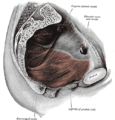Pelvic floor
This article needs more primary sources. (August 2018) |  |


The pelvic floor or pelvic diaphragm is an anatomical location in the human body,[1] which has an important role in urinary and anal continence, sexual function and support of the pelvic organs.[2] The pelvic floor includes muscles, both skeletal and smooth, ligaments and fascia.[3] and separates between the pelvic cavity from above, and the perineum from below.[citation needed] It is formed by the levator ani muscle and coccygeus muscle, and associated connective tissue.[4]
The pelvic floor has two hiatuses (gaps): (anteriorly) the urogenital hiatus through which urethra and vagina pass, and (posteriorly) the rectal hiatus through which the anal canal passes.[5]
Structure
Definition
Some sources do not consider "pelvic floor" and "pelvic diaphragm" to be identical, with the "diaphragm" consisting of only the levator ani and coccygeus, while the "floor" also includes the perineal membrane and deep perineal pouch.[6] However, other sources include the fascia as part of the diaphragm.[7] In practice, the two terms are often used interchangeably.[citation needed]
Relations
The
Posteriorly, the pelvic floor extends into the anal triangle.[citation needed]
Function
It is important in providing support for pelvic
Clinical significance


The pelvic floor is subject to clinically relevant changes that can result in:
- Anterior vaginal wall prolapse
- Cystocele (bladder into vagina)[8]
- Urethrocele (urethra into vagina)
- Cystourethrocele (both bladder and urethra)
- Posterior vaginal wall prolapse
- Enterocele (small intestine into vagina)
- Rectocele (rectum into vagina)
- Apical vaginal prolapse
- Uterine prolapse (uterus into vagina)
- Vaginal vault prolapse (roof of vagina) - after hysterectomy
Pelvic floor dysfunction can result after treatment for gynecological cancers.[9]
Damage to the pelvic floor not only contributes to urinary incontinence but can lead to pelvic organ prolapse. Pelvic organ prolapse occurs in women when pelvic organs (e.g. the vagina, bladder, rectum, or uterus) protrude into or outside of the vagina. The causes of pelvic organ prolapse are not unlike those that also contribute to urinary incontinence. These include inappropriate (asymmetrical, excessive, insufficient) muscle tone and asymmetries caused by trauma to the pelvis. Age, pregnancy, family history, and hormonal status all contribute to the development of pelvic organ prolapse. The vagina is suspended by attachments to the perineum, pelvic side wall and sacrum via attachments that include collagen, elastin, and smooth muscle. Surgery can be performed to repair pelvic floor muscles. The pelvic floor muscles can be strengthened with Kegel exercises.[10]
Disorders of the posterior pelvic floor include rectal prolapse, rectocele, perineal hernia, and a number of functional disorders including anismus. Constipation due to any of these disorders is called "functional constipation" and is identifiable by clinical diagnostic criteria.[11]

Pelvic floor exercise (PFE), also known as
Perineology or pelviperineology is a specialty dealing with the functional troubles of the three axes (urological, gynecological and coloproctological) of the pelvic floor.[17]
Additional images
-
The pelvic floor muscles span the bottom of the pelvis. This image shows the left levator ani from within.
See also
- Coccyx (tailbone)
- Female genital prolapse
- Pelvic floor dysfunction
- Perineology
- Perineal hernia
- Pubococcygeus muscle
- Vaginal support structures
- Vesicovaginal fistula
References
![]() This article incorporates text in the public domain from page 420 of the 20th edition of Gray's Anatomy (1918)
This article incorporates text in the public domain from page 420 of the 20th edition of Gray's Anatomy (1918)
- PMID 29489277. Retrieved 2023-10-13.
- S2CID 235492234.
- PMID 34575049.
- ^ "Pelvic Floor Muscles: Anatomy, Function & Conditions". Cleveland Clinic. Retrieved 2023-03-16.
- ^ ISBN 978-81-312-2556-1.
- ISBN 978-0-443-06612-2.
- PMID 16985905.
- ^ "Cystocele (Prolapsed Bladder) | NIDDK". National Institute of Diabetes and Digestive and Kidney Diseases. Retrieved 2017-12-02.
- PMID 28929201.
- ^ PMID 12806450.
- PMID 16720016.
- ^ PMID 15971718.
- PMID 19578656.
- ^ a b "Pelvic Floor Dysfunction: Symptoms, Causes & Treatment". Cleveland Clinic. Retrieved 2023-03-16.
- PMID 37588123.
- PMID 32029399.
- S2CID 12964013.



